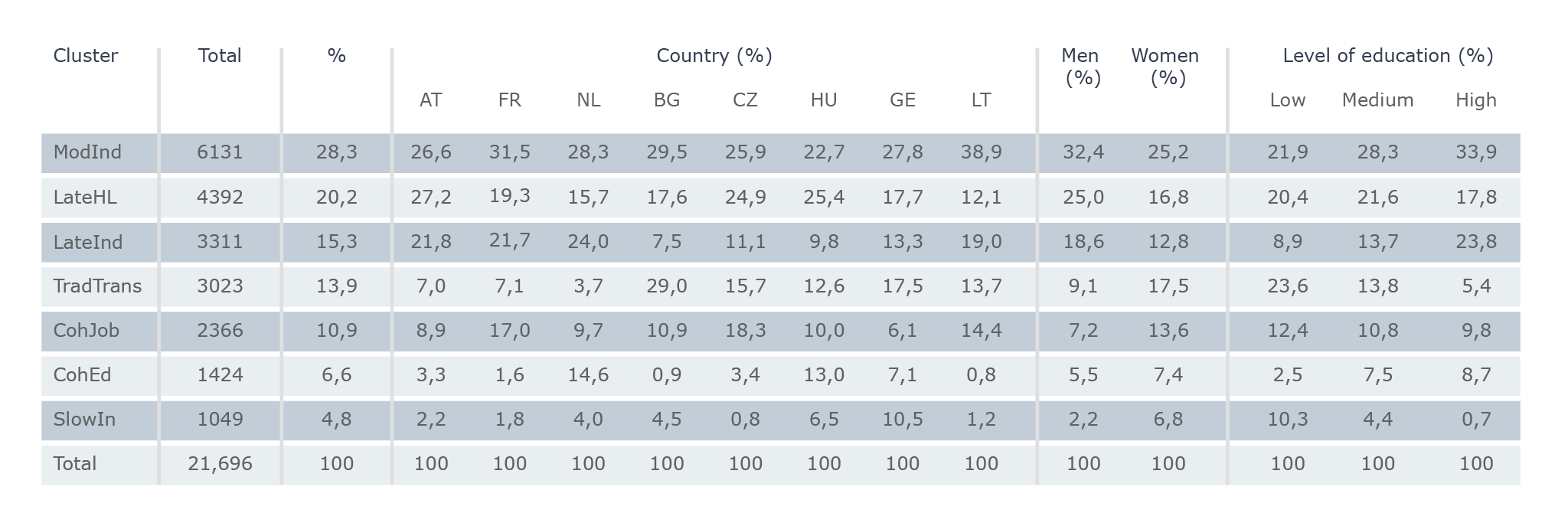When do young Europeans move out from their parents’ home? When do they start working? When do they get married? So far, and mostly due to data availability, little research actually focuses on the transition to adulthood from a European perspective. In this study, K. Schwanitz contributes to the literature by comparing transitions to adulthood in eight European countries (Austria, Bulgaria, Czech Republic, France, Georgia, Hungary, Lithuania and the Netherlands). Using data from the Generations and Gender Survey (GGS), she examines whether there are similarities in their transition to adulthood and how gender, country and educational level shape the life course of young Europeans
Schwanitz takes into account their residential, partnership and employment trajectories, and identifies seven different patterns where the transition occurred at various speeds (see Table 1). For instance, young Europeans belonging to the “Modern and Independent” (ModInd) group – the largest group – entered the labour market early, but stayed at their parents’ home for a relatively long time (until 21 years old). They did not necessarily marry directly after moving out and tended to cohabitate longer. Young adults from the “Cohabiting with Education” (CohEd) group lived longer with their parents (until 25 years old), but tended to prioritize their education.

Table 1: Average duration in each life course state by cluster (years).
Source: Schwanitz (2017) based on data from GGS Wave 2 (2006-2013)
By looking at the distribution of these patterns between countries, gender and educational groups, Schwanitz was able to draw three main conclusions.
First, countries strongly shape the transition to adulthood. For instance, modern life course pathways such as ModIn, LateHL, and LateInd (characterised by a late exit from the parents’ home, being single for a longer period of time and cohabitation) were more common in West European countries. On the other side, more traditional patterns (TradTrans, CoHed and SlowIn) were more likely to occur in East European countries where young adults followed more classical pathways (they completed their education, started working, married early and then had their first child relatively soon) (see Table 2).
Second, there are important gender differences in the life course of young Europeans. For instance, there is a higher share of women in the groups TradTrans and CohJob where young adults started working early (before 20) and tended to prioritize family formation. Young European men, however, were much more likely to leave their parents’ home later, to stay longer in education (LateHL and LateInd) and to postpone partnership and family formation (ModInd).
Finally, the role played by education is not the same in all countries. Young adults with higher levels of education were more likely to delay the moment when they left the parental home and started having children. However, the effect of education was highly influenced by the country. For instance, educational levels had a positive effect for young East Europeans following a more modern pathway (ModIn) whereas it had no significant effects for young Europeans from Austria, France and the Netherlands.

Table 2: Characteristics of the clusters of pathways to adulthood and cluster distribution by country, sex and education.
Note: AT= Austria, FR = France, NL = Netherlands, HU = Hungary, CZ = Czech Republic, LT = Lithuania, BG = Bulgaria, GE = Georgia
Source: Schwanitz (2017) based on data from GGS Wave 2 (2006-2013)
This publication is partly funded by the Horizon 2020 Research and Innovation Programme under grant agreement n° 739511 for the project Generations and Gender Programme: Evaluate, Plan, Initiate